From the moment I learned this Filipino-style paella recipe from my cousin Ate Dimple, it transformed my approach to celebration cooking. Like many cherished family recipes passed down through generations, this one carries both Spanish culinary heritage and distinctly Filipino touches that make it truly special.
After countless weekend lunches watching her create this showstopping dish, carefully layering the perfectly spiced chicken, premium seafood, and chorizo de bilbao over saffron-infused rice, I've mastered her techniques for achieving that coveted golden socarrat (tutong) and beautifully arranged toppings that make this paella a true centerpiece of Filipino festivities.
This time-tested Filipino paella recipe combines straightforward techniques with impressive results that will have your guests thinking you've been making paella all your life.
Jump to:
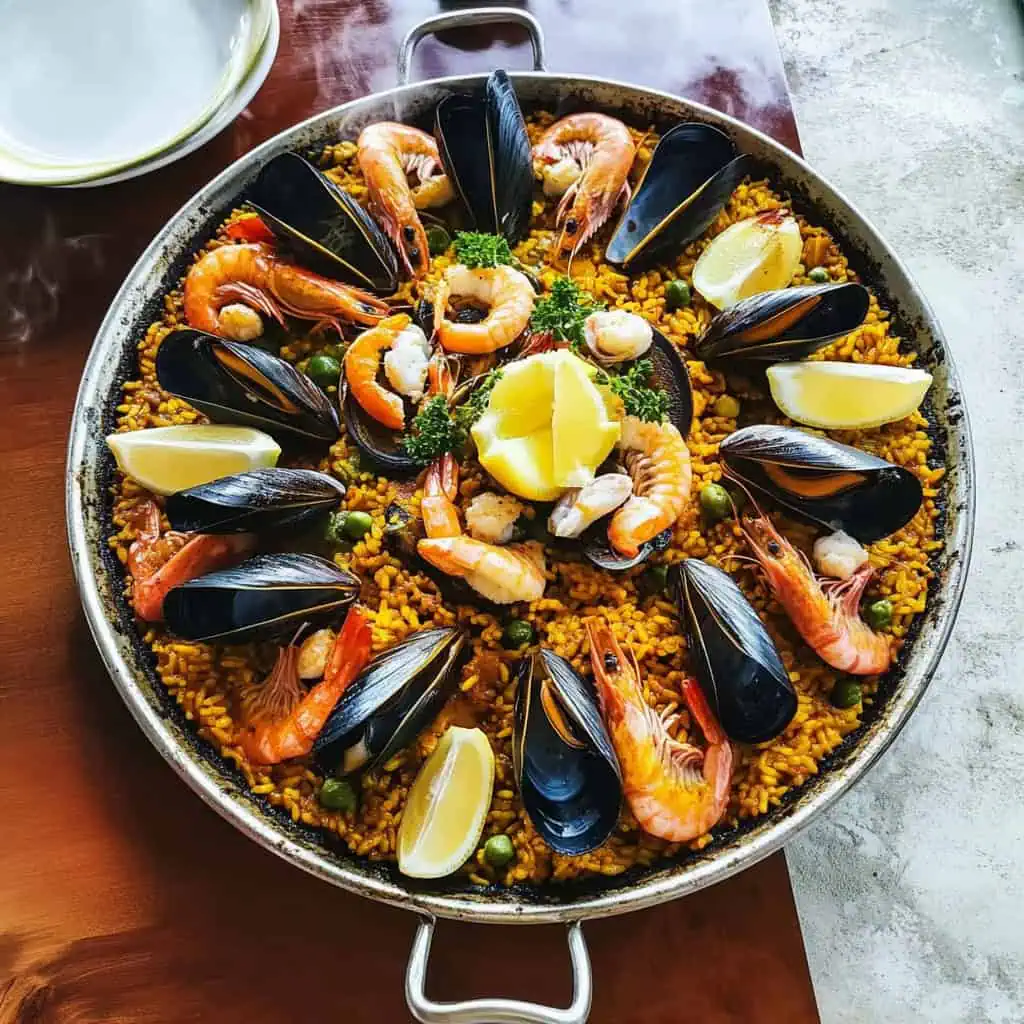
Why You'll Love This Recipe
- Perfect for Celebrations: Ideal for fiestas, Noche Buena, or special family gatherings
- Make-Ahead Friendly: Most prep can be done in advance
- Scalable: Easy to adjust portions for different crowd sizes
- Impressive Presentation: Restaurant-worthy look with minimal effort
- Budget Flexible: Can be adapted with different proteins based on your budget
- Beginner-Friendly: Clear step-by-step instructions with Tagalog translations
Ingredients
This Filipino-style paella combines ingredients that create perfect harmony in both flavor and texture. Long grain rice forms the foundation because it stays fluffy while absorbing the rich flavors.
Saffron adds the signature golden color and floral aroma, while the combination of land and sea proteins (chicken, chorizo, shrimp, and mussels) provides contrasting textures and a depth of flavor unique to Filipino celebrations. The aromatic base of garlic, onion, and paprika creates an essential flavor foundation, while tomato sauce adds tanginess and helps develop the coveted socarrat (crispy bottom).
Each ingredient plays a vital role in creating a dish that balances tradition with Filipino culinary personality.

For the Rice Base:
- 4 cups long grain rice
- 1 teaspoon saffron threads (or 2 teaspoons turmeric)
- 8 cups warm water
- 1 cup tomato sauce
For the Proteins:
- 3 pounds whole chicken, cut into serving parts
- 5 ounces chorizo de bilbao, sliced thickly
- 1 pound large shrimp, deveined
- 1 dozen mussels, cleaned and debearded
For the Aromatics:
- 3 cloves garlic, minced
- 1 onion, finely chopped
- 1 tablespoon sweet paprika
- 2 tablespoons olive oil
- Salt and pepper to taste
Equipment Needed
- Paellera or wide, shallow pan (24-28 inches): The traditional wide, shallow shape allows proper rice cooking and formation of socarrat (crispy bottom)
- Measuring cups and spoons: For precise ingredient measurements
- Sharp knife: For cutting proteins and aromatics
- Cutting board: For food preparation
- Kitchen tongs: For arranging and turning proteins
- Aluminum foil: For covering the paella during cooking
- Wooden spoon: For stirring and scraping the bottom of the pan
- Fine mesh strainer: For rinsing rice
- Small bowl: For steeping saffron
- Large mixing bowl: For marinating chicken
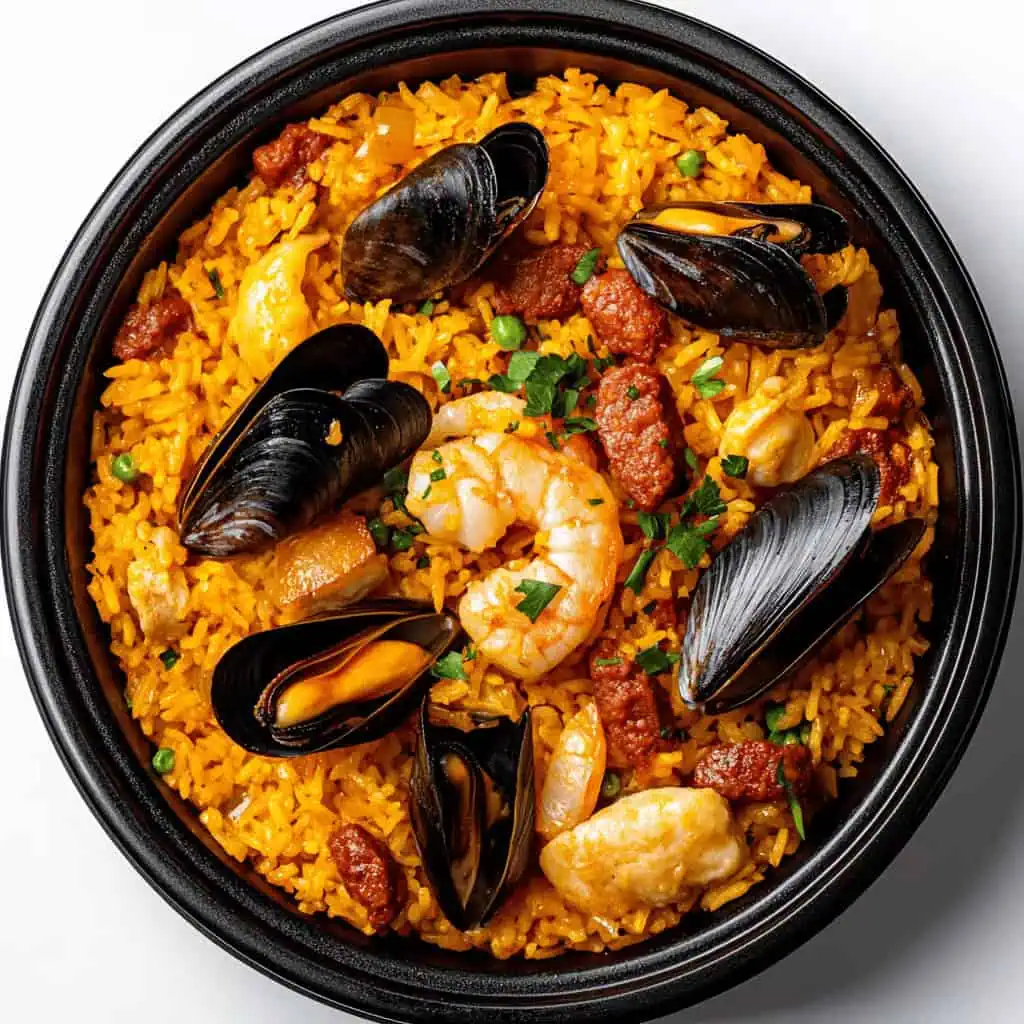
How To Make
- Start with marinating the chicken. Season chicken pieces with paprika, salt, and pepper. Make small cuts in the meat for better flavor absorption and refrigerate for 30 minutes.
- Meanwhile, prepare the seafood. Clean the shrimp by removing heads and shells but keeping tails intact. Clean and debeard the mussels. For the rice, rinse once and steep saffron in ¼ cup warm water for 15 minutes.
- Heat the paellera or wide pan over medium heat. Add olive oil and cook sliced chorizo de bilbao until oils release, about 3-4 minutes. Remove and set aside, keeping the flavored oil in the pan. In the same oil, brown the marinated chicken pieces (5-7 minutes per side) until golden brown, then remove.
- Create the sofrito base by sautéing minced garlic until golden (1 minute), then add chopped onions and cook until translucent (3-4 minutes). Add tomato sauce and cook until slightly reduced (5 minutes), scraping the bottom to release flavors.
- Add rice to the pan and stir to coat with sauce. Pour in the saffron water and remaining warm water. Bring to a boil. Once boiling, STOP STIRRING. Return chicken and chorizo, arranging in a decorative pattern. Reduce heat to low, cover with foil, and cook for 15 minutes.
- Remove foil and arrange shrimp and mussels in a circular pattern, pushing slightly into rice. Replace foil and cook for 10 minutes. For the socarrat (tutong), remove foil and increase heat to medium-high for 2-3 minutes until you hear a crackling sound. Remove from heat, keep covered, and let rest for 10 minutes before serving.

Tips from Lola's Kitchen
- Rice Selection: While traditional Spanish paella uses Bomba rice, our local premium rice varieties work well too. Choose rice that's newly harvested for best results.
- Achieving Proper Water Ratio: The rice-to-water ratio should be 1:2. If your paella seems dry during cooking, add hot water ¼ cup at a time.
- Layering Flavors: Brown meats properly before adding liquids to develop deep flavor base.
- Saffron Value: Real saffron is expensive but worth it. Use just a pinch and steep properly to extract maximum color and flavor.
- One-Pan Method: Don't be tempted to use separate pans—the flavors developing in a single pan are essential.
- Perfect Socarrat: To achieve the coveted crusty bottom, listen for a crackling sound in the final minutes of cooking. If you smell burning, immediately reduce heat.
- Rest Period: The 10-minute rest after cooking is critical for flavor development and moisture distribution.
Traditional Serving Suggestions
- Serve directly from the paellera
- Garnish with lemon wedges and fresh parsley
- Pair with:
- Crusty bread
- Cucumber salad
- Spanish-style pickled vegetables
- Chilled white wine or sangria
Substitutions
- Saffron: Use turmeric mixed with a few threads of kasubha (safflower) for color and a hint of floral aroma
- Chorizo de Bilbao: Spanish chorizo or Hungarian sausage can work, but add a bit of smoked paprika to compensate
- Mussels: Substitute with clams or additional shrimp if mussels aren't available
- Tomato Sauce: Use 4 fresh tomatoes (diced) plus 2 tablespoons tomato paste
- Long Grain Rice: Japanese short grain rice can work but reduce water by ¼ cup
- Seafood Alternatives: Skip shellfish and add firm white fish pieces in the last 5 minutes of cooking
- Vegetarian Option: Replace all animal proteins with grilled vegetables like bell peppers, artichokes, and mushrooms
Troubleshooting
- Rice Too Wet
- Cause: Too much liquid or lid opened too often
- Solution: Remove foil, increase heat slightly and cook uncovered for additional 3-5 minutes
- Rice Not Cooking Evenly
- Cause: Uneven heat distribution
- Solution: Rotate pan every 5 minutes during cooking process
- Seafood Overcooked
- Cause: Added too early in the cooking process
- Solution: Add shrimp and mussels only during the last 8-10 minutes of cooking
- No Socarrat Forming
- Cause: Heat too low or pan too thick
- Solution: Increase heat for final 3 minutes and listen for crackling sound
- Burning Bottom Before Rice Cooks
- Cause: Heat too high throughout cooking
- Solution: Use lowest heat setting for majority of cooking time, only increasing at the end
Storage & Reheating
Storage:
- Refrigerator: Store in an airtight container for up to 3 days
- Freezer: Not recommended for seafood version, but chicken-only paella can be frozen for up to 2 months
Reheating:
Stovetop Method:
- Add 2-3 tablespoons water to prevent drying
- Heat on medium-low, covered
- Stir occasionally to distribute heat evenly
- Heat until internal temperature reaches 165°F
Microwave Method:
- Sprinkle 1 tablespoon water over each cup of paella
- Cover with microwave-safe lid or damp paper towel
- Heat in 2-minute intervals at 70% power
- Stir between intervals
- Allow to stand 1 minute before serving
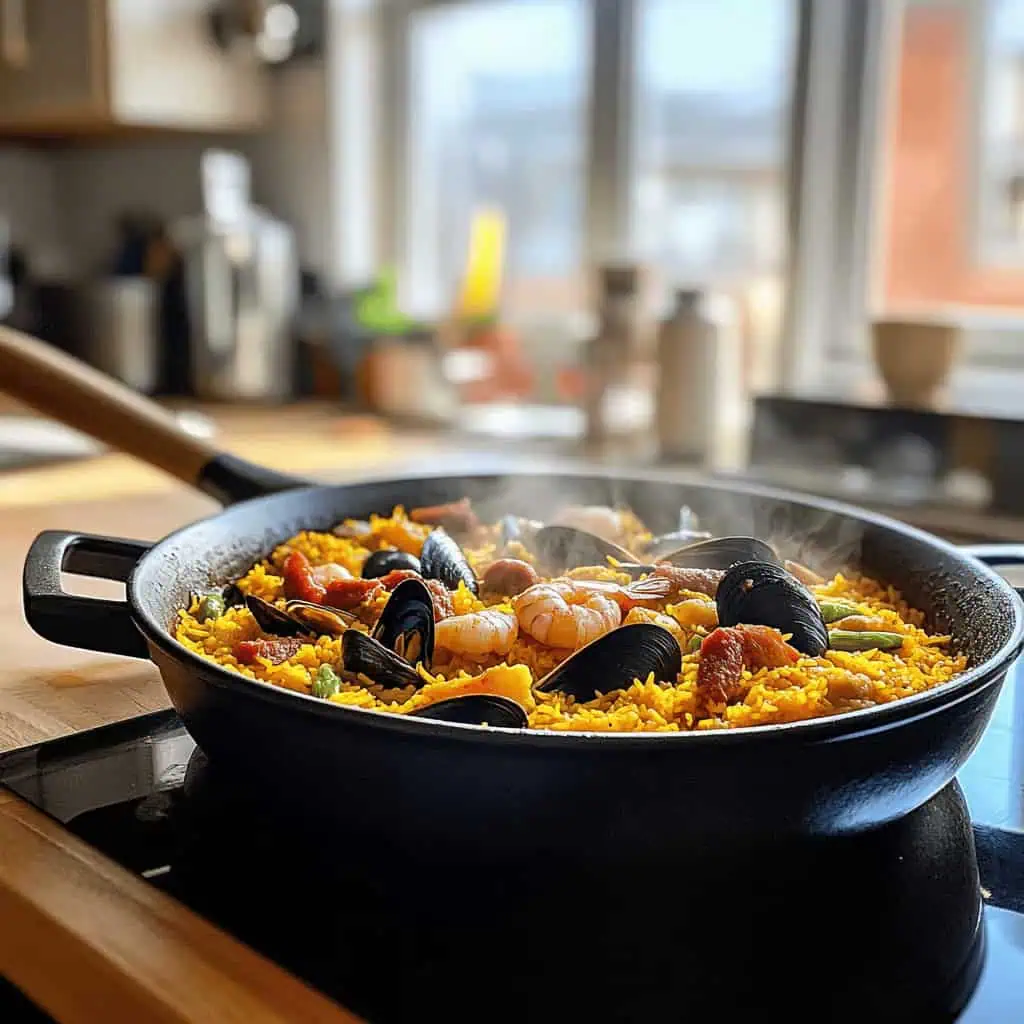
FAQ
Can I make this ahead for a party?
Best served fresh, but you can prepare all components ahead and assemble 4-6 hours before serving. Complete the final cooking just before guests arrive.
Why is my rice different colors?
Saffron distribution might be uneven. For more consistent color, steep saffron in warm water first, then stir well before adding to rice.
Can I use a regular pan instead of a paellera?
Yes, but ensure it's wide and shallow for proper evaporation. The wider the pan, the thinner the rice layer, which helps achieve the perfect texture.
How do I know when the paella is done?
The rice should be tender but still have a slight bite (al dente), most liquid should be absorbed, and you should hear a gentle crackling as the bottom layer forms the socarrat.
Can I double this recipe?
Yes, but use multiple pans rather than one larger deeper pan to maintain the correct rice depth.
Is paella gluten-free?
This recipe is naturally gluten-free, but always check your chorizo ingredients as some may contain fillers.
How spicy is this recipe?
This version is mild. For more heat, add 1-2 chopped red chilies with the aromatics.
Can I make this vegetarian?
Yes! Replace proteins with grilled vegetables and use vegetable broth instead of water for deeper flavor.
Related
Looking for other recipes like this? Try these:
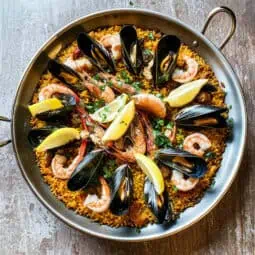
Filipino-Style Paella
Equipment
- Paellera or wide, shallow pan (24-28 inches)
- Measuring cups and spoons
- Sharp knife
- Cutting board
- Kitchen tongs
- Aluminum foil
Ingredients
For the Rice Base:
- 4 cups long grain rice bigas
- 1 teaspoon saffron threads asafrón or 2 teaspoons turmeric (luyang dilaw)
- 8 cups warm water mainit na tubig
- 1 cup tomato sauce
For the Proteins:
- 3 pounds whole chicken cut into serving parts (manok)
- 5 ounces chorizo de bilbao sliced thickly
- 1 pound large shrimp hipon, deveined
- 1 dozen mussels tahong, cleaned and debearded
For the Aromatics:
- 3 cloves garlic bawang, minced
- 1 onion sibuyas, finely chopped
- 1 tablespoon sweet paprika pulang paminta
- 2 tablespoons olive oil
- Salt asin and pepper (paminta) to taste
Instructions
- Start with marinating the chicken. Season chicken pieces with paprika, salt (asin), and pepper (paminta). Make small cuts in the meat for better flavor absorption and refrigerate for 30 minutes.
- Meanwhile, prepare the seafood. Clean the shrimp (hipon) by removing heads and shells but keeping tails intact (tanggalin ang ulo at balat, pero iwan ang buntot). Clean and debeard the mussels (linisin at tanggalin ang buhok ng tahong). For the rice (bigas), rinse once and steep saffron (asafrón) in ¼ cup warm water for 15 minutes.
- Heat the paellera or wide pan over medium heat. Add olive oil and cook sliced chorizo de bilbao until oils release, about 3-4 minutes. Remove and set aside, keeping the flavored oil in the pan. In the same oil, brown the marinated chicken pieces (5-7 minutes per side) until golden brown, then remove.
- Create the sofrito base by sautéing minced garlic (bawang) until golden (1 minute), then add chopped onions (sibuyas) and cook until translucent (3-4 minutes). Add tomato sauce and cook until slightly reduced (5 minutes), scraping the bottom to release flavors.
- Add rice to the pan and stir to coat with sauce. Pour in the saffron water and remaining warm water (mainit na tubig). Bring to a boil. Once boiling, STOP STIRRING (huwag nang haluin). Return chicken and chorizo, arranging in a decorative pattern. Reduce heat to low, cover with foil, and cook for 15 minutes.
- Remove foil and arrange shrimp and mussels in a circular pattern, pushing slightly into rice. Replace foil and cook for 10 minutes. For the socarrat (tutong), remove foil and increase heat to medium-high for 2-3 minutes until you hear a crackling sound. Remove from heat, keep covered, and let rest for 10 minutes before serving.
Tips from Lola's Kitchen
- Rice Selection: While traditional Spanish paella uses Bomba rice, our local premium rice varieties work well too. Choose rice that's newly harvested for best results.
- Saffron Substitute: If saffron is too expensive, combine turmeric with kasubha (safflower) for color and aroma.
- Perfect Socarrat: To achieve the coveted crusty bottom, listen for a crackling sound in the final minutes of cooking.
Nutrition
The Story Behind Our Authentic Filipino Paella Recipe
Every Filipino celebration has a story, and our love affair with paella is one that spans oceans and generations. While many know this golden rice dish as Spain's national treasure, its transformation into a beloved Filipino celebration staple reveals the beautiful marriage of colonial influence and Pinoy ingenuity. This easy homemade paella recipe carries not just flavors, but centuries of shared history between two cultures.
In the sun-soaked region of Valencia, Spain, where traditional paella was born, farmers would cook this hearty rice dish over wood fires in the open fields. They used whatever ingredients were at hand – rabbit, snails, and local vegetables. But when this cooking technique reached Philippine shores during the Spanish colonial period, our resourceful Lolas adapted it to match our tropical abundance. The rabbits were replaced with chicken, our bountiful seas provided the freshest seafood, and local spices found their way into the mix.
Today, the best Filipino-style paella holds a special place in our cuisine, particularly during Noche Buena and town fiestas. Walk through any barangay during a celebration, and you'll likely catch the mouthwatering aroma of saffron-infused rice cooking in someone's kitchen. It's become such an integral part of our food culture that many Filipino families now consider their paella recipe as valuable as their heirloom jewelry – passed down from generation to generation with pride and careful instruction.
What makes our authentic Filipino paella unique is how we've made it our own. While Spanish paella strictly follows traditional rules, our version embraces the Filipino spirit of "freestyle" cooking. Some families add a splash of patis for extra umami, others swear by their secret garlic-to-onion ratio, and in some regions, they even incorporate local ingredients like aligue (crab fat) or guinamos (shrimp paste) for that distinctly Pinoy twist.
Despite its fancy reputation, this homemade paella recipe proves that with patience and the right guidance, any Filipino home cook can master this impressive dish. Whether you're cooking for a simple family Sunday lunch or preparing for a grand celebration, this recipe carries the warmth of Filipino hospitality and the pride of our culinary heritage.
When we say "lutong bahay" (home-cooked), we're talking about dishes like this – ones that bring families together around the table, inspire storytelling, and create memories that last generations. This isn't just about cooking rice with seafood and meat; it's about continuing a delicious tradition that has become uniquely ours. From Valencia's farmlands to Filipino family gatherings, paella has truly found its second home in our hearts and our hapag-kainan.
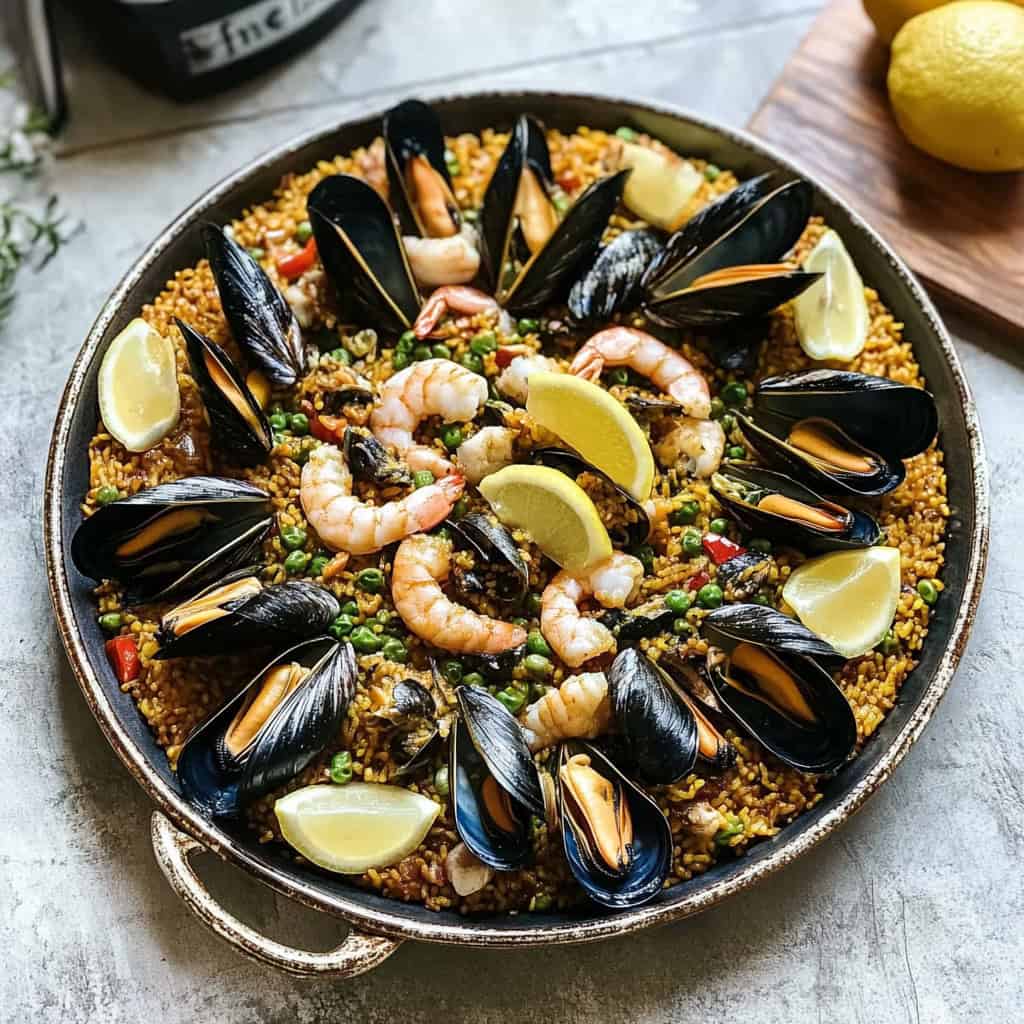





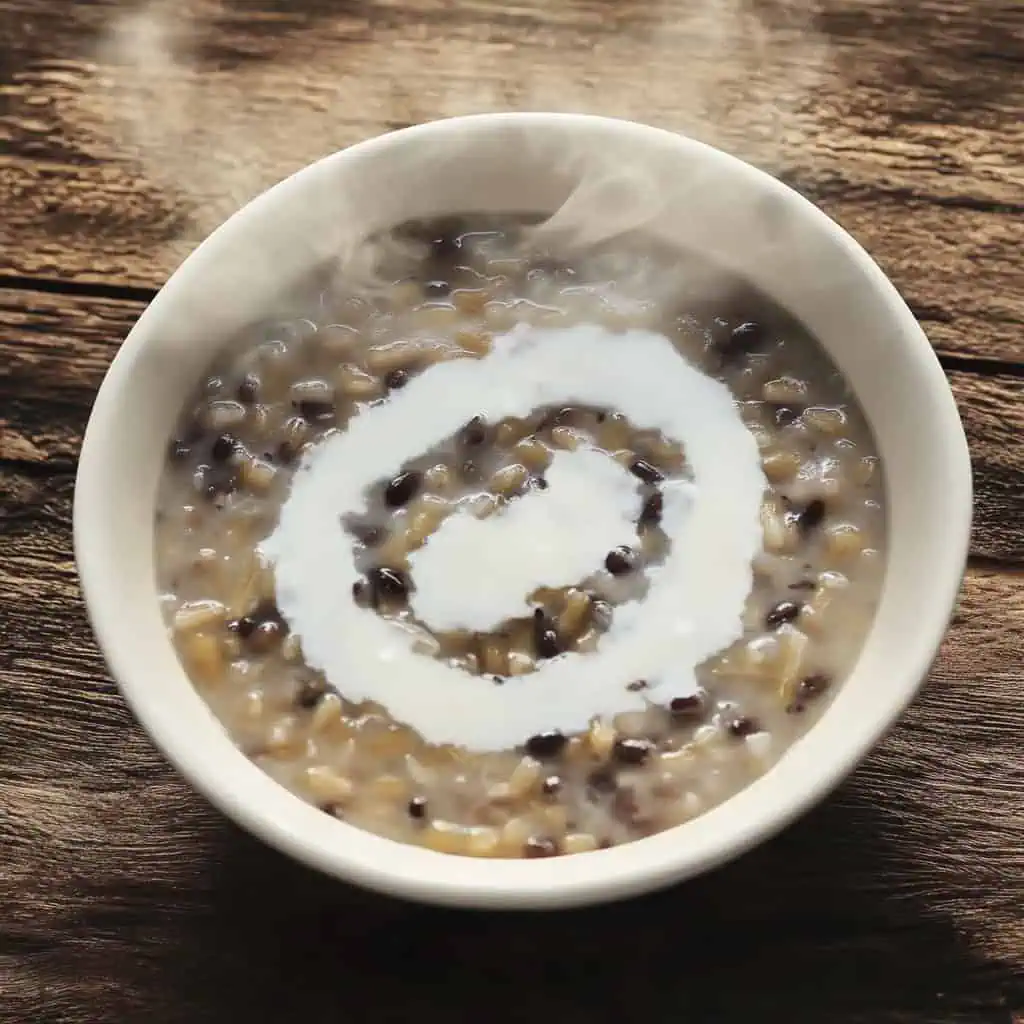
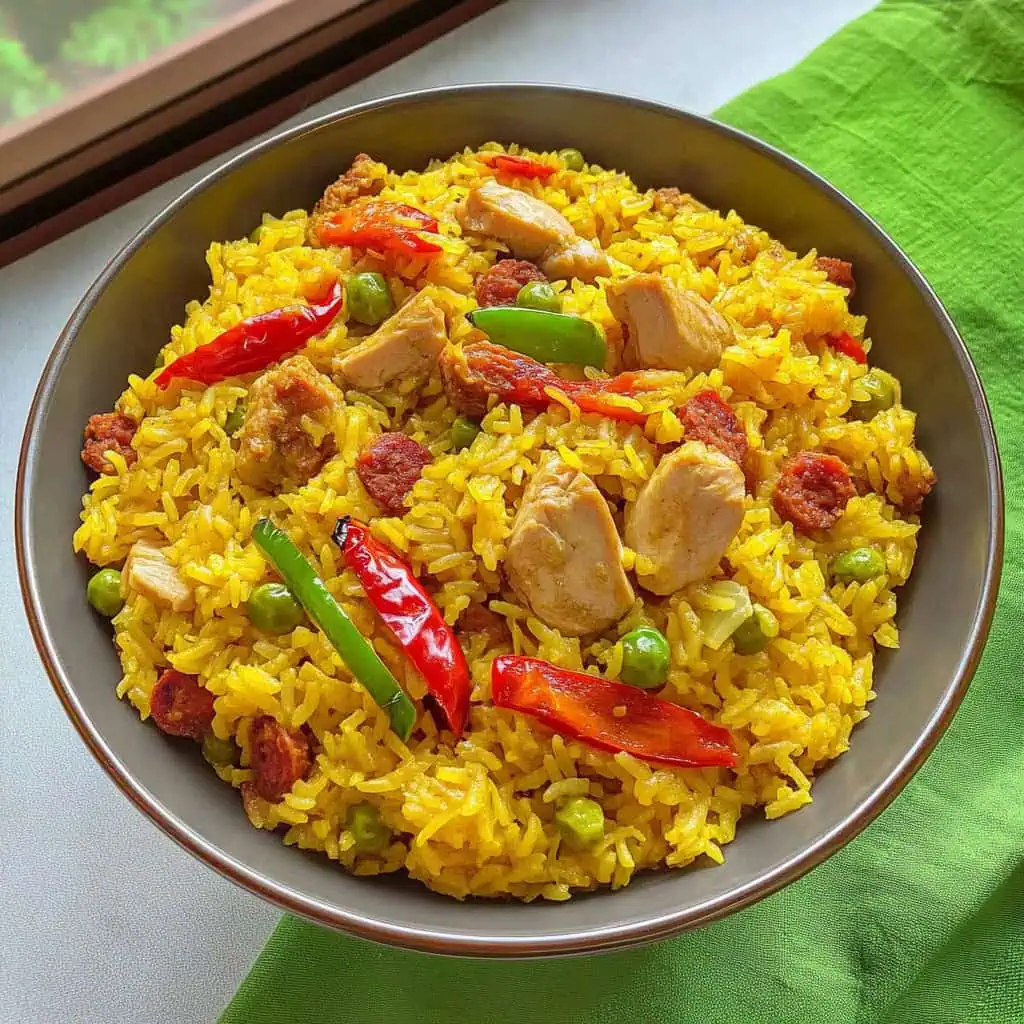
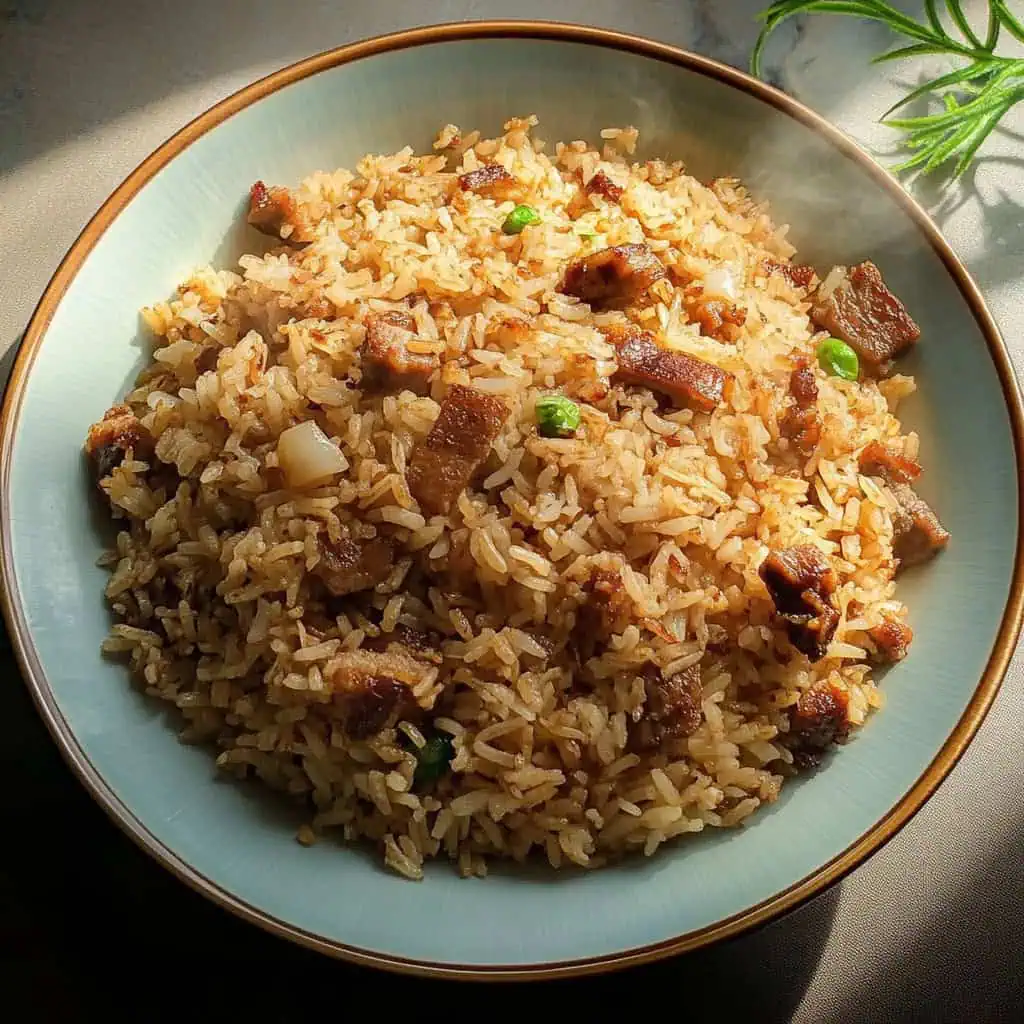
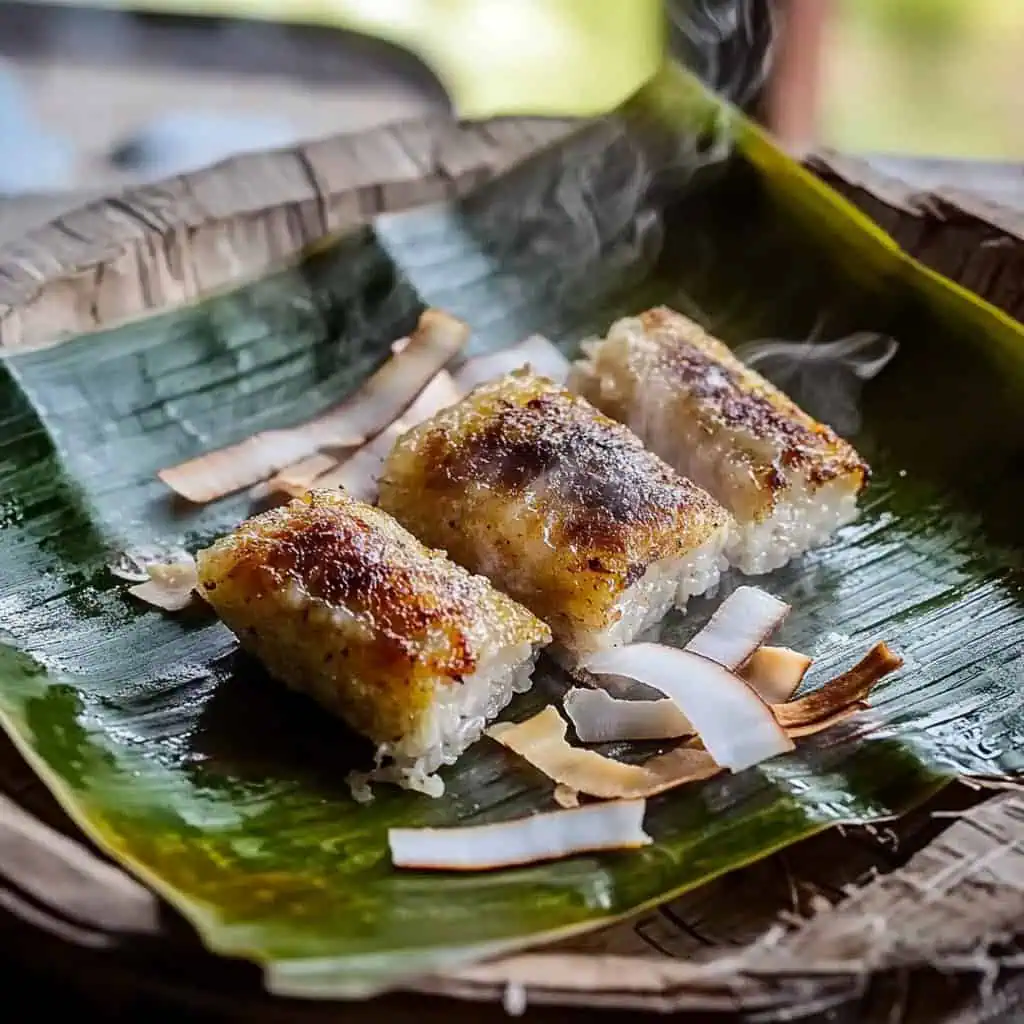
Comments
No Comments